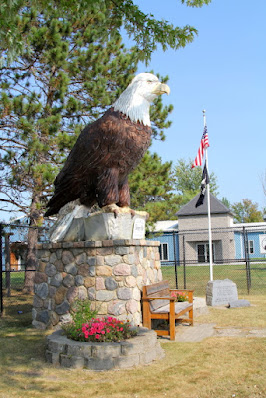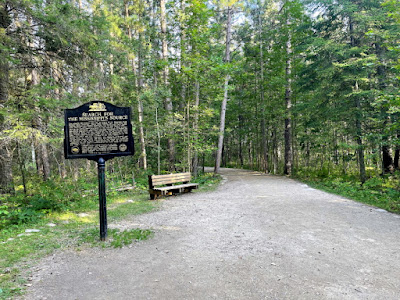Bena (population 143) is located on the south shore of Lake Winnibigoshish and home of "The Big Fish," a 65-foot long, 15-foot wide, Muskie. The fish's round red eyes are Coca-Cola signs.
Big Fish was originally built in 1958 as Big Muskie Drive-In Restaurant that served hamburgers and ice cream. The drive-in restaurant was only open a few years before Big Fish became a souvenir stand and then incorporated into The Big Fish Supper Club.
Big Fish is considered one of the seven wonders of Minnesota and was featured on Charles Kuralt's On the Road television series. Kuralt said it was his favorite building in America. It was also featured in the 1983 film National Lampoon's Vacation.
Also located in Bena is Big Winnie General Store. The store was built in 1932 and is a good example of 1930's Bavarian Architecture, as influenced by Frank Lloyd Wright. Wright was staying at the lake when he met Earnest Flemming and the two became good friends. Flemming told Wright that he wanted to build a gas station on the site; but since all gas stations looked alike a that time, he wanted to build something with with an Asian and Bavarian theme to the building. Wright sketched out the current building for him. The building was constructed and the business in now operated by Flemming's Great-Great Grandson
When I was in Grand Rapids, I decided to "Follow the Yellow Brick Road" because "There's No Place Like Home."
Judy Garland's birthplace home has been restored and is now a museum attached to a Children's Discovery Museum. The museum has many of Garland's artifacts and personal items, along with "The Wizard of Oz" items. She was married 5 times and had three children, the most famous being Liza Minnelli. Garland died at age 47 from a barbiturate overdose.
In the side yard, there a number of opportunities for Wizard of Oz head-through-a-hole photo ops.
As I drove into Remer (population 391), I noticed signs that said: "Remer Welcomes You" and "Home of Big Foot." Along main street there were Sasquatch hiding behind street light poles and in some parking lots.
Remer is also the location of Thunder Lake Lodge, which was Al Capone's favorite place to vacation in Minnesota.
Located in downtown Remer is a veterans memorial with a 10-foot tall eagle statue.
Akeley (population 404) is home of the Paul Bunyan Historical Museum and the "Worlds Largest Paul Bunyan Statue." The museum is only open during the summer months, but the statue is next to the road and can be photographed anytime. Many people take a photo standing or sitting in Paul's outstretched hand.
Paul weighs over 5 tons and is about 35-feet tall when kneeling. However, if he stood up, he would be close to 60-feet tall. His hair and beard are made from resin-soaked twine that if laid end-to-end would be over a mile long.
Nevis (population 377) is home of the 30-foot-long "World's Biggest Tiger Muskie." Muskie are native to the waterways in this area and Nevis Muskie Days are held each year in July.
Tiger Muskie are difficult to catch because they are a hybrid offspring of the true Muskie and are usually sterile. Because the Tiger Muskie are a hybrid species, they are said to have "hybrid vigor" and grow 1.5 times faster than a typical Muskie. Tiger Muskie are also less susceptible to disease.
The Mary Gibbs Mississippi Headwaters Center is located in Itasca State Park near the shore of Lake Itasca. This is where the "Mighty Mississippi River" begins as a small stream and eventually makes its way to the Gulf of Mexico. Water leaving from Lake Itasca actually flows north before making a semicircle and then flow south. From the air, the water flow pattern looks like an upside-down fishhook.
Itasca State Park is Minnesota's oldest state park. It was established in 1891to protect the headwaters of the Mississippi River and the stands of virgin pine in the surrounding basin. The Mississippi River is the longest river in the United States and drains one-eight of the North American continent.
Not far from the visitor center is a bridge that crosses the Mississippi River and steps that lead down to the river so that visitors can touch the water.
To reach the actual headwaters requires a short hike to Lake Itasca. A historical marker along the trail explains that Henry Schoolcraft was the first European to view the headwaters. In 1832 Ojibwe Chief Ozawindib guided Schoolcraft to the lake and headwaters when Schoolcraft was in the area to negotiate a treaty between the Dakota and Ojibwe Indian tribes. At that time the lake was called "Omushkos," meaning Elk Lake. Schoolcraft renamed the lake "Itasca" from a combination of the Latin words for "truth" and "head."
At the lake's edge, there is a dead tree trunk painted brown with the following message: "Here 1475 feet above the ocean, the mighty Mississippi begins to flow on its winding way 2552 miles to the Gulf of Mexico." It has now been determined that the actual distance is 2340 miles.
I walked across the "Big Muddy" Mississippi River on the rocks that were high and dry. At this point, the "Big Muddy" is clear and cool, so I soaked my hand in the running water.
Mahnomen's (population 1,240) town name comes from the Ojibwe word "manoomin," meaning wild rice, which grows in the area.. The Wild Rice River passes through Mahnomen before it joins the Red River on its way to the Mississippi River. Mahnomen is the count seat for Mahnomen County and there is a nice veterans memorial in front of the courthouse.
Ada (population 1,740) is the county seat for Norman County. When Ada was incorporate in 1874, the county was larger than it is today. Several communities wanted to be the county seat, so the county residents voted on the site location and Ada won by 1 vote. There is a soldier monument in front of the courthouse named "Lest We Forget" in memory of the Norman County residents that gave their lives in war.
At the Syre Junction of Highways 32 and 113, there were two historic grain elevators that were more picturesque than they appear in my picture.
Ulen ([population 476) is an interesting small town that was settled by Norwegians and continues to have a Nordic influence. The town's museum contains what may be an authentic "Viking sword" that was found in a field by Hans O. Hansen in 1911 when he was plowing his field. Because the soil was dry that year, he set the plow to be extra deep and the sword turned up in the deeper soil.
The sword has a 16-inch blade and the pommel and the crossguard are made of brass. There are designs on both sides of the sword. One side depicts a helmeted soldier and on the other side is a breastplate design covered with a dagger and two crossed axes.
Archeologist have examined the sword and said that it bears little resemblance to any sword of known early Medieval provenance. They said that the sword may be Germany, rather than Viking, but they can find nothing like it from Germany. No one can find any clue as to how the sword ended up buried in a farmer's field near Ulen. Historically, the sword was called "The Viking Sword," but it is now referred to as "The Ulen Sword."
Arriving in Audubon (population 560), the first thing I noticed was a church with a floating steeple; however, I was looking for Minnesota's Largest Purple Martin House. Because it was really getting dark, I had a hard time finding the Martin House, but I finally located it behind the Audubon Liquor Store.


















































No comments:
Post a Comment